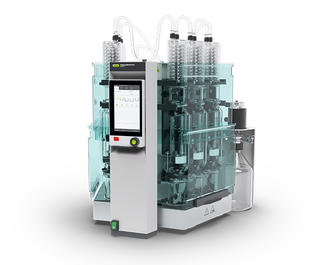UniversalExtractor E-800
Powerful and perfect for multitasking.
The UniversalExtractor E-800 is perfectly suited to any demanding extraction task. Six distinct extraction positions enable individual process control and simultaneous operation of different extraction methods. High-speed heaters combined with sophisticated process control allow for the fastest and most reproducible extraction processes.
Multitasking
- Six distinct extraction positions enable individual process control and simultaneous operation of different extraction methods.
- Multiple work packages can be executed in parallel.
- Faster method development and higher sample throughput.
Analyte protection sensor
- Patent pending analyte protection always guarantees that only a minimum level of solvent in the beaker can be found, which results in best analyte recoveries.
- Prevents the deterioration and degradation of heat sensitive analytes during all process steps.
- Ensures safe and reproducible concentration of the extract.
Fully inert conditions and maximized safety for the analyte
- All components in the UniversalExtractor E-800 that are in contact with the sample and the solvents are made of completely inert material.
- Eliminates sample contamination and any memory effects from leaching materials.
- The inert gas supply, selectable at all process steps (extraction, rinsing, drying) protects the analyte against oxidation.
- Inert gas is automatically switched on if the analyte protection sensor is triggered.
Flexible applications
- Profit from five different extraction methods in one universal glass assembly. Choose the optimal extraction method to achieve best recoveries and low result variation.
- For low contaminated samples, the Large Sample Volume (LSV) glass assembly can expand the sample volume used to the extraction by 60 %.
- Fast and equal heating, even for high boiling solvents such as water or toluene.
Optimal sample size: The LSV glass assembly with the larger extraction chamber and beaker allows for the use of higher sample quantities needed to achieve the required detection limit of the analyte. The main glass parts are enlarged by 60 %.
High performance condensers: The large condenser captures vapours efficiently and ensures highest solvent recovery (> 90 %), even with volatile solvents. Any emission of vapours is eliminated and allows for operation outside of the fume hood.
Full visibility: The entire extraction process is visible. The glass assemblies can be easily accessed and disassembled for cleaning and for decontamination in the oven (baking out at + 450 °C).
Analyte protection sensor: Monitors the solvent level in the beaker and prevents the beakers of running dry. For a safer process and best protection of heat-sensitive analytes.
UniversalExtractor E-800 ECE
The UniversalExtractor E-800 ECE is designed for economic and fast extraction of various samples for quality control. Six distinct extraction positions enable individual process control. The automated continuous extraction method ensures simple method selection and easy operation. High extraction efficiency with low variation combined with reduced solvent consumption guarantee cost savings.
UniversalExtractor E-800 Standard / LSV
The UniversalExtractor E-800 Standard / E-800 Standard LSV is perfectly suited to any demanding extraction task. Six distinct extraction positions enable individual process control and simultaneous operation of different extraction methods. The LSV(Large sample volume) version allows for the use of higher sample quantities needed to achieve the required detection limit of the analyte.
UniversalExtractor E-800 Pro / LSV
The UniversalExtractor E-800 Pro / E-800 Pro LSV is perfectly suited to any demanding extraction task. It supports up five different extraction methods, freely selectable by the extraction position. High-speed heaters and extraction chamber heaters combined with sophisticated process control allow for the fastest and most reproducible extraction processes. The LSV (Large sample volume) version allows for the use of higher sample quantities needed to achieve the required detection limit of the analyte.








